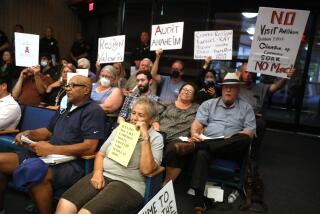Odyssey Leads to Chance at ‘Real Reform’ for Advocates
WASHINGTON — Three political fund-raising scandals. Two maverick presidential campaigns. One White House veto. And more than a decade of frustration, reversals and dashed hopes.
That’s what it has taken for supporters of campaign finance reform to reach a House vote expected today that may constitute their best chance yet to force their vision into law.
In their decade-plus of struggle, reformers have been compelled to ruthlessly narrow their aims. Their bills once sought to comprehensively reduce the influence of money in politics. Now the reformers have pared back to a single goal: blocking the flow of unlimited big money contributions into political campaigns.
Even if they push their current bill into law, that may not reduce the amount of money spent on politics, supporters acknowledge. But the legislation would severely curtail the system of loosely unregulated “soft money” financing that has become the fastest-growing source of money in politics and threatened to swamp the fund-raising limits imposed after the Watergate scandal.
“Obviously, when supporters say this is going to get money out of politics, that’s hype,” said Harvard University lecturer Michael Waldman, who oversaw the campaign finance issue for President Clinton. “But this is real reform. It will at least for a few elections shut down the most egregious features of the current system. The most fundamental thing this would do is restore the idea that there are some limits.”
And that alone could change the way campaigns look in the next few years, though perhaps not only in ways that reform advocates predict. The bill’s critics believe that its provisions targeting independent groups--such as restrictions on the airing of political ads funded by unions or corporations--are much less likely to survive judicial challenges than those affecting political parties. That could produce a system where interest groups have more freedom to spend and shape the campaign dialogue than candidates and parties.
The impending House vote stands as the latest collision of the two forces that have shaped the debate over campaign finance reform for more than a decade. On one side has been the embedded reluctance of many lawmakers to change fund-raising rules that they believe have helped them win their seats. On the other has been a succession of money scandals and reform movements that have generated public pressure for change.
“One of the constants here has been the problem keeps getting worse and the national support keeps getting bigger and we [reform advocates] never go away,” said Fred Wertheimer, president of Democracy 21, one of the groups pressing for reform.
The result has been a series of legislative showdowns in which Congress has taken up the reform banner, fought to stalemate, set the issue aside and then been forced to begin the process again after a new spike of public outrage.
Just since 1990, the House has passed reform bills five times and the Senate four times (while filibusters thwarted Senate action in four other years). Yet through all that, no bill has become law.
Lawmakers enacted the last major change in the campaign finance laws after Watergate in 1974, creating the modern system of contribution limits and public financing for presidential general elections.
As loopholes emerged in that system, the first proposals to further tighten the flow of money into campaigns surfaced in the mid-1980s. But it wasn’t until the early 1990s that the effort took off.
Scandal, as it would repeatedly, provided a key boost. Controversy surrounding the efforts of five senators on behalf of failed savings and loan tycoon Charles H. Keating encouraged Democrats (who then controlled the House and Senate) to pass sweeping campaign finance legislation in 1990 and 1992. But internal disagreements killed the first bill and then-President Bush, as the legislators expected, vetoed the second.
The drive was revived after the 1992 election, when Ross Perot’s strong third-party showing demonstrated a substantial constituency for reform. But congressional Democratic leaders, who had eagerly passed reform legislation under a president they knew would veto the bill, hesitated to do so under Clinton, who had pledged to sign it.
Though bills passed both chambers, House Democratic leaders refused to reconcile their differences with the Senate through late 1994, effectively killing the legislation. Clinton had labeled reform one of his top goals but failed to intervene as the Democrats interred it.
The reform effort appeared to die when Republicans, generally skeptical of the idea, seized control of Congress in 1995. But scandal again revived it in 1997, when outrage over Clinton’s 1996 reelection fund-raising tactics spurred a new push led by Sens. Russell D. Feingold (D-Wis.) and John McCain (R-Ariz.), who embraced the reform cause after being tainted as one of the senators linked to Keating.
This new effort came with a narrowed focus. The legislation that repeatedly cleared Congress in the early 1990s sought to comprehensively reduce the flow of money into politics. It included voluntary spending limits for congressional campaigns (usually in return for some federal funding), limits on fund-raising by political action committees and a ban on unlimited soft money contributions to the parties.
Since 1997, though, the reform bills have dropped the other provisions to focus on the soft money ban and a parallel effort to block interest groups from using unlimited contributions to fund independent advertising campaigns.
Even so, the efforts still foundered. Although the House passed the new reform bills in 1998 and 1999, the Senate could never overcome a GOP filibuster. Indeed, some House members are suspected of supporting the bills because they knew the legislation could not overcome Senate filibusters.
Yet, once again, when the legislation appeared dead, outside forces have provided new momentum. McCain’s strong performance in the 2000 GOP presidential primaries--like Perot’s showing in 1992--helped propel a reform bill through the Senate last year. Now, Enron Corp.’s collapse has brought the House effort to the brink of success. The Enron backdrop has also discouraged President Bush from actively opposing the legislation, though the ban on soft money is more sweeping than he prefers.
Reform supporters are already dampening expectations that the legislation would transform politics, should it become law. Soft money accounts for only about one-sixth of the roughly $3 billion spent on federal elections in 2000, according to the nonpartisan Center for Responsive Politics.
But the bill’s supporters say unlimited soft money contributions, used to fund party-sponsored “issue” advertising campaigns, have become the system’s most severe problem by undermining the Watergate-inspired contribution limits. In the last three presidential races, the parties have effectively run parallel campaigns, one funded with money raised under the spending limits, the other with soft money. Now that approach is migrating into congressional races.
Critics say banned soft money would inevitably find other ways into campaigns. Many predict a proliferation of independent spending campaigns, particularly if the courts strike down as a violation of free speech the legislation’s efforts to constrain such groups.
“They think they are going to be shutting off soft dollars by shutting off the parties, but it is just going to seep to groups like us,” said Steve Moore, president of the Club for Growth, a conservative political action committee.
Wertheimer too has no illusions that this week could mark any kind of final victory. Even if a bill reaches Bush and he signs it, Wertheimer said, reformers will have to begin new efforts, such as replacing the Federal Election Commission with a new enforcement body. “Every step in this process is always hard,” Wertheimer said. “So even if we win, I’m not celebrating anything.”
More to Read
Get the L.A. Times Politics newsletter
Deeply reported insights into legislation, politics and policy from Sacramento, Washington and beyond. In your inbox three times per week.
You may occasionally receive promotional content from the Los Angeles Times.










